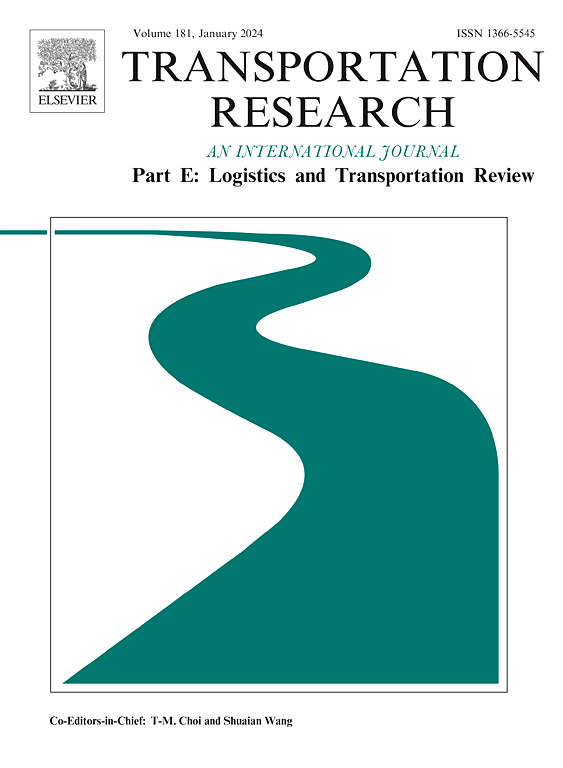需求和价格不确定情况下基于概率预测的海运远期运费市场采购
IF 8.3
1区 工程技术
Q1 ECONOMICS
Transportation Research Part E-Logistics and Transportation Review
Pub Date : 2024-10-30
DOI:10.1016/j.tre.2024.103830
引用次数: 0
摘要
运费和航运需求的波动给租船人和船东带来了财务风险。运费远期协议(FFA)是一种流行的套期保值工具,通过指定协议到期时的运输货物数量,提前确定运费。利用远期运费协议做出采购决定需要评估未来的运费和航运需求。接受高于未来 FFA 和现货价格的 FFA 报价,或采购高于实际需求的数量,都会给租船人带来风险。我们考虑了租船人的运费采购问题,即在价格和需求不确定的情况下,利用 FFA 和现货市场使预期总成本最小化。我们的研究表明,当价格和需求预测没有更新时,随着需求期的临近,与状态相关的基本库存政策是最佳的,基本库存水平不会下降。为了确定基础库存水平,我们提出了基于概率预测的政策,并更新了预测和基础库存水平递增政策(IBP),根据距离需求期的剩余期数调整基础库存水平。利用涵盖不同市场条件的合成数据和来自 14 条散货和油轮航线的真实数据,将所提出的方法与基准方法进行了比较。评估期涵盖危机前(2016-2019 年)和危机期间(2020-2023 年),并考虑到 2019 年之后的重大事件,如 COVID-19 大流行病和导致市场剧烈波动的俄乌冲突。数值评估表明,基于概率预测的政策优于基于点预测的政策。利用概率需求预测的成本低于概率价格预测。市场数据实验表明,IBP 的平均成本最低,同时由于符合最优采购政策,避免了过度采购。由于在波动的货运市场中存在预测偏差,IBP 优于基于概率预测的政策。本文章由计算机程序翻译,如有差异,请以英文原文为准。
Probabilistic forecast-based procurement in seaborne forward freight markets under demand and price uncertainty
Volatility in freight rates and shipping demand poses financial risks for charterers and ship owners. Freight forward agreements (FFAs) are popular hedging tools for fixing freight rates in advance by specifying the amount of cargo to be transported at the maturity period of the agreement. Procurement decisions with FFAs require assessing future freight rates and shipping demand. Accepting an FFA price offer higher than future FFA and spot prices or procuring a larger amount than the actual demand constitutes risks for charterers. We consider the freight procurement problem of a charterer, minimizing the total expected cost using FFA and spot markets under price and demand uncertainty. We show that a state-dependent base-stock policy is optimal with non-decreasing base-stock levels as the demand period approaches when price and demand forecasts are not updated. To determine base-stock levels, we propose probabilistic forecast-based policies with updated forecasts and an increasing base-stock level policy (IBP) adjusting base-stock levels based on the number of periods left until the demand period. The proposed methods are compared with benchmark methods using synthetic data covering different market conditions and real data from 14 bulk and tanker routes. The evaluation period covers pre-crisis (2016–2019) and during-crisis periods (2020–2023), considering major events after 2019, such as the COVID-19 pandemic and the Russia–Ukraine conflict, which led to high market volatility. Numerical evaluations show that policies based on probabilistic forecasts outperform those based on point forecasts. Utilizing probabilistic demand forecasts results in lower costs than probabilistic price forecasts. Experiments on the market data show that IBP results in the lowest cost on average while avoiding excessive procurement due to being in line with the optimal procurement policy. IBP outperforms probabilistic forecast-based policies due to forecast biases in the volatile freight market.
求助全文
通过发布文献求助,成功后即可免费获取论文全文。
去求助
来源期刊
CiteScore
16.20
自引率
16.00%
发文量
285
审稿时长
62 days
期刊介绍:
Transportation Research Part E: Logistics and Transportation Review is a reputable journal that publishes high-quality articles covering a wide range of topics in the field of logistics and transportation research. The journal welcomes submissions on various subjects, including transport economics, transport infrastructure and investment appraisal, evaluation of public policies related to transportation, empirical and analytical studies of logistics management practices and performance, logistics and operations models, and logistics and supply chain management.
Part E aims to provide informative and well-researched articles that contribute to the understanding and advancement of the field. The content of the journal is complementary to other prestigious journals in transportation research, such as Transportation Research Part A: Policy and Practice, Part B: Methodological, Part C: Emerging Technologies, Part D: Transport and Environment, and Part F: Traffic Psychology and Behaviour. Together, these journals form a comprehensive and cohesive reference for current research in transportation science.

 求助内容:
求助内容: 应助结果提醒方式:
应助结果提醒方式:


